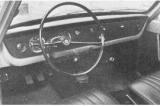|

A sports model, the STC-16, was produced between 1973 and 1975. The first prototype was introduced in 1972. Designed by Eralp Noyan, a turkish designer, the STC-16 was the first Turkish sports car. It was also the second completely Turkish designed car after Devrim which was produced in 1961 as the first Turkish designed and built automobile.
In 1971 Erdogan Gonul, the General Manager of Otosan and the son-in-law of Vehbi Koc, convinced the latter on the production of a sports car. The car was aimed at the upper segment of the Turkish market and would participate in international rallies, thus bringing prestige to the Anadol brand. The creation works of the STC-16 were assigned to Turkish designer Eralp Noyan, who had graduated from the Royal Fine Arts Academy in Belgium. The STC-16 was a completely new Anadol and looked nothing like the previous models of the brand. The design of the STC-16 had similarities with the sports car models of that period such as the Datsun 240Z, SAAB Sonett, Aston Martin, Ginetta and Marcos, but the overall form of the car had a unique and distinct character. Eralp Noyan was particularly inspired by the Supermarine Spitfire aircraft of World War II when designing the interior and exterior of the car.The STC-16 used a shortened and modified Anadol H-frame chassis and suspension system, while using a 82 HP (5200 rpm) 1599cc Ford Kent Crossflow OHV with cast iron block engine. The transmission system, on the other hand, was the one that was used by some high performance Cortina and Capri models in Britain. The STC-16 had all the typical dashboard gauges and indicators which the British and Italian sports cars of that period had. Apart from the speed and RPM indicators, a resettable cruise distance indicator (something new for that period) as well as a Lucas ampermeter and Smiths oil, fuel and engine temperature indicators were installed on the dashboard.Following an initial development period of 11 months, the first 3 prototypes of the STC-16 became ready for road tests, which took place at the Cengiz Topel Airport and the section of the E-5 highway between Istanbul and Adapazari. The first crash tests of the STC-16 were also performed in this period. Afterwards, the STC-16 was taken to England by Nihat Atasagun, Otosan's Production Manager, who tested the car at the M.I.R.A. circuit. The car received great attention at the streets and highways of England, where most people thought that it was the prototype of a new British sports car. Several traffic police officers stopped the car in England, which had a special testing licence plate, "320-E", for receiving more information about the new model. The STC-16 was tested by British pilots at the circuit, and modifications were made according to their suggestions, following which the car's performance and safety characteristics were improved. Finally, at the beginning of April 1973, the first STC-16 rolled out of the Otosan factory in Istanbul and went into the showroom. The car's name, "STC-16", was originally an acronym for "Sport Turkish Car 1600". But as it was also intended for international markets, STC was alternatively named as the "Sport Touring Coupé". Among the Turkish youth, however, STC was interpreted as "Süper Türk Canavarı" (Super Turkish Monster).
Unfortunately, the global oil crisis of 1973 meant bad news for the STC-16. Not only car fuel became more expensive, but the cost of building fiberglass (which is a petrochemical product) car bodies such as that of the STC-16 also sky-rocketed. The rear-wheel drive STC-16's engine consumed a lot of fuel, and the sport coupé market in Turkey appealed to a very small segment, particularly to the young members of high-income families. Unlike other Anadol models of that period which were sold for 50,000 to 55,000 Turkish Liras, the STC-16 had a price tag of more than 70,000 Turkish Liras. When all these factors came together, the primary customers of the STC-16 remained the rally drivers, sports car enthusiasts and young celebrities.Nevertheless, the STC-16 became synonymous with its era in the memory of that period's Turkish youth, and the upgraded competition version of the car won numerous victories in rally competitions in Turkey and Europe. Famous Anadol STC-16 rally pilots included Renc Kocibey, Demir Bukey, Romolo Marcopoli, Iskender Aruoba, Cihat Gurkan, Ali Furgac, Sevki Gokerman, Serdar Bostanci, Murat Okcuoglu, Cuneyd Isıngor, Mehmet Becce, Hizir Gurel, Derya Karakose and Osman Arabaci. Instead of the heavy steel chassis of the road version STC-16, the rally version used a much lighter FRP chassis, combined with a modified 140 bhp (104 kW/142 PS) engine.Anadol STC-16 model, with the homologation documents by FIVA (old FIA), has been in the classical cars list and they can participate to the international classical car races. A total of 175 (except 3 prototypes in 1972) Anadol STC-16 have been produced between 1973 and 1975, most of them in 1973, until the global oil crisis in that year reduced demand and slowed down production. Most of the STC-16s were painted to "Alanya Yellow"[ Ford Signal Yellow (Akzo Skala: FEU1022-KL)], which became synonymous with the car. Some of them were painted to red with white racing stripes, and some to white with blue racing stripes, as was fashionable with the sports cars of that period.
|










































































